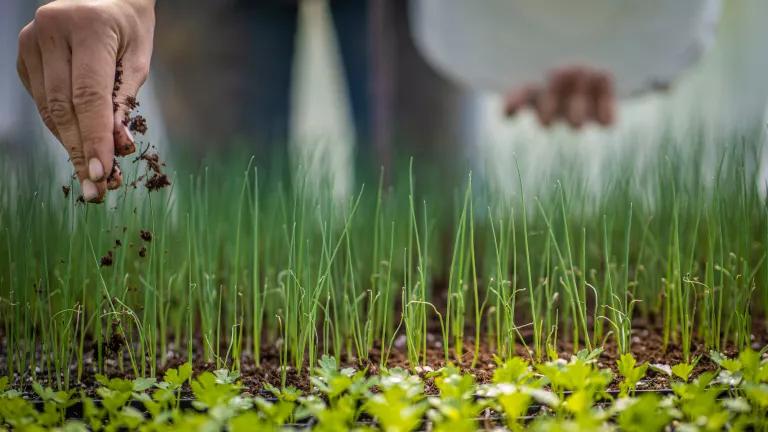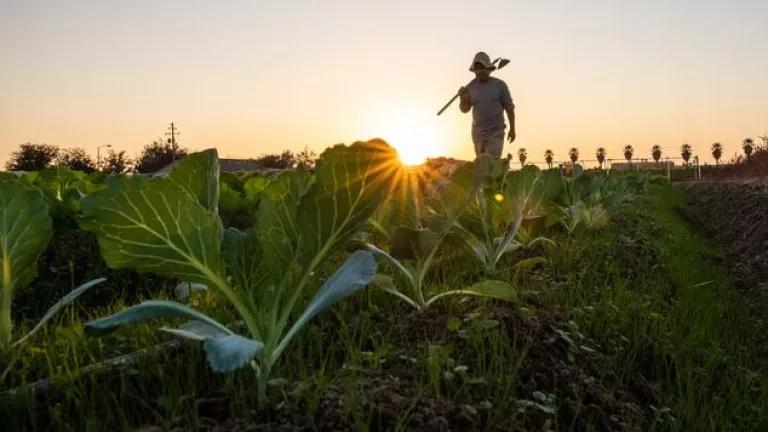To Keep Global Food Supply Secure: More Plants, Less Waste
Earlier this month, the United Nations released the third report from leading scientists in the past year warning of the impending, dire impacts of climate change if we don’t take immediate, bold action.
The headline of this latest report, the Global Assessment Report on Biodiversity and Ecosystem Services, was jarring: 1 million species are at risk of extinction. If you could read past that, the report went on to reveal that global food security for humans is also in jeopardy as a result of related impacts, such as disappearing pollinators, reduced agricultural yields, and a decline in fish populations.
It’s true that these are tremendously worrisome findings. But as important as it is to understand the gravity of these threats, it’s even more important to know that they are not a forgone conclusion. There is still time. But we need to act big, and act fast. And we need all hands on deck.
As NRDC’s Chief Program Officer, Susan Casey-Lefkowitz, put it:
“Many of the tools to fix our global problems are there...I hope [this] assessment will be the signal we all need to start taking aggressive action. Rather than curl up in a ball in fear, I prefer to visualize the better, brighter, fairer, safer, more lovely world that will result from taking the actions necessary.”
When it comes to our food supply, what we eat (and what we don’t eat) matters. The New York Times recently published a detailed consumer guide on all of the ways individuals can fight climate with their forks (check it out here, if you haven’t already seen it—it’s fantastic!).
But two big ways to build that rosier future through our diets stand out: Eat more plants. Waste less food. With strong action in homes, corporate board rooms and legislatures around the country to do these two things, together we can realize the climate-fighting potential on our plates.
What we eat
Some foods have a bigger environmental footprint than others because they require more land, water, fertilizer and/or energy than others to grow, transport or store. The biggest offender is livestock raised for meat or dairy products. Cows release large amounts of methane—a climate change pollutant 80 times more potent than carbon dioxide in the short term—from their digestive tracts. All livestock require large amounts of animal feed, which is greenhouse gas-intensive to grow. Animals produced through intensive farming also produce large amounts of manure, which generates even more climate pollution.
The United States consumes more beef and veal than most of the world. In 2014, beef was responsible for 34 percent of the average American’s diet-related greenhouse gas emissions. Fortunately, we are making progress: Changes in Americans’ diets from 2005 to 2014—particularly a 19 percent drop in beef consumption—resulted in a total reduction in climate pollution equivalent to the tailpipe emissions created by 57 million cars in one year.
By eating more fruits, vegetables, legumes and grains —and making even modest reductions in the amount of meat and dairy we consume—we can take an even bigger bite out of climate pollution moving forward. In fact, if every American cut just one hamburger a week (which averages about a quarter pound of beef) from their diet, we could cut emissions as much as taking about 10 million cars off the road each year. If you want to make a difference, cutting your beef consumption is a powerful and easy place to start.
While consumers have enormous potential to fight climate change with their forks, we also need action from our lawmakers and food businesses to make the climate-friendly choice an easier choice.
Food service companies like Aramark can play an enormous role because they feed millions of people daily at large places like stadiums, universities and hospitals around the country. Offering more plant-based options and reducing their meat offerings (for instance, by blending mushrooms into their burgers) could have a big impact. Not only would this be good for the planet, it would likely be good for business too, as it would bring their menus more in line with what modern consumers are demanding. We urge large food businesses to take scientists’ warnings seriously and do their part by establishing comprehensive climate change emissions reduction commitments that include reducing purchases of climate-intensive foods.
Our lawmakers at the local, state and federal levels should also play their part by making sure public policy and incentives reflect the new climate reality and favor food purchasing that is less-climate intensive. New York City recently took a big step when it set a goal of cutting municipal beef purchases by half by 2040. And a bill currently before the California legislature (AB 479) would provide schools with additional funding to provide climate friendly, plant-based meals and beverages. Cities and states across the country should embrace impactful measures like these. And at the federal level, the USDA’s Dietary Guidelines should reflect the scientific consensus that a diet with less meat and more plant-based foods will make both people and the planet more healthy.
What we save
We can also fight climate change by making sure we’re eating the food we produce rather than letting it land in the trash. Right now, up to 40 percent of food in the U.S. is never eaten. When we throw away food, we’re throwing away all the water, energy, land and more that went into producing it. We’re also creating more methane pollution when it rots away in a landfill. In fact, if the food wasted around the globe were a country, it would have the 3rd highest climate footprint on the planet behind only China and the U.S.
Consumers are the largest single source of this waste—but the silver lining in that reality is this: if you eat food, you can be part of the solution. Small steps—such as buying only what we actually need, storing food to maximize its shelf life, and eating leftovers—add up to make a big collective difference. NRDC’s Save The Food campaign with the Ad Council has a host of easy ideas for consumers at SaveTheFood.com.
Just as policy-makers and the business sector have a role to play in rethinking our food choices, they can also help make big strides in tackling food waste. Aramark, for instance, has already established a goal to cut their food waste by 50% by 2030, as have companies ranging from Campbell’s, to Kellogg’s and Hilton Hotels. Other companies should adopt similarly aggressive targets and strong implementation plans to reach them.
Federal lawmakers can also help by reducing confusion around date labels on food (such as “Sell By” and “Use By”). Federal legislation supported by NRDC would standardize these date labels and educate consumers on ways to enjoy their food rather than tossing it prematurely. Cities like Denver and Nashville are also taking leadership to set food waste reduction targets and boost donation of surplus food by grocery stores and other companies to those in need.
There is still time to tackle our climate change challenges. We can win the climate battle and protect global food security, but we need all hands on deck.



